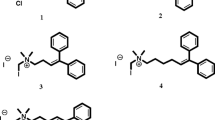Abstract
The pharmacokinetics of Sb was examined in 29 patients with cutaneous leishmaniasis following the intramuscular administration of a dose of sodium stibogluconate equivalent to 600 mg of Sb. Blood was sampled at different time intervals from each patient and Sb was measured in whole blood by electrothermal atomic absorption spectrophotometry after an appropriate dilution with Triton X-100. The 24-hr urine- was also collected and analyzed similarly. The blood concentration-time data conformed to the one-compartment open model with mean and (SEM) of the apparent first-order rate constants for absorption (ka) and elimination (kd) of 1.71 (0.15) and 0.391 (0.016) hr−1, respectively. The maximum concentration of Sb achieved was 8.77 (0.39) mg/L and the peak time was 1.34 (0.09) hr. The total body clearance (TBC) and the volume of distribution (Vd) were 17.67 (1.38) L/hr and 45.7 (2.6) L, respectively, assuming a complete absorption. The fraction of dose of Sb excreted in the urine was 0.80 (0.07) and the renal clearance was 12.7 (1.16) L/hr. The frequency distribution pattern of the area-under-the-curve (AUC) appears to be bimodal and separates patients into those with low exposure to Sb (AUC = 11.7-29.04 mg.hr/L) (i.e., rapid eliminators) and those with high exposure to Sb (AUC = 31.5-49.1 mg.hr/ L) (i.e., slow eliminators). This may explain the variability observed in the response to treatment of leishmaniasis with sodium stibogluconate.
Similar content being viewed by others
REFERENCES
D. J. B. Wijers. A ten year's study of kala-azar in Tharaka (Meru District, Kenya) II Relapses. East Afr. Med. J. 84:551–558 (1971).
L. Yan-Jia. A review of kala-azar in China from 1948 to 1959. Trans. Roy. Soc. Trop. Med. Hyg. 76:531–537 (1982).
A. D. M. Bryceson, J. D. Chulay, M. Ho, M. Mugambii, J. B. Were, R. Muigai, C. Chunge, G. Gachihi, J. Meme, G. Anabwani, and S. M. Bhatt. Visceral leishmaniasis unresponsive to antimonial drugs I. Clinical and immunological studies. Trans. Roy. Soc. Trop. Med. Hyg. 79:700–704 (1985).
S. Belazzoug and R. A. Neal. Failure of meglumine antimonate to cure cutaneous lesions due to Leishmania major in Algeria. Trans. Roy. Soc. Trop. Med. Hyg. 80:670–671 (1986).
S. Allen and R. A. Neal. The in vitro susceptibility of macrophages infected with amastigotes of Leishmania spp. to pentavalent antimonial drugs and other compounds with special relevance to cutaneous isolates. in D. T. Hart, (ed.), Leishmaniasis the Current Status and New Strategies for Control, Series A Life Sciences, 163:711–720 (1989).
R. Kirk and M. H. Sati. Observation on the use of sodium antimony gluconate: (sodium stibogluconate in the treatment of kala-azar). Ann. Trop. Med. Hyg. 52:199–204 (1947).
E. Tuckman. Treatment of Chinese kala-azar with sodium antimony gluconate. J. Trop. Med. Hyg. 52:199–204 (1949).
T. McKenzie. Analytical data for the GTA-95. In E. Rothery (ed.), Analytical Methods for Graphite Tube Atomizer, Varian Techtron, Milgrave, Victoria, Australia, 1982, pp. 25–48.
M. Gibaldi and D. Perrier. Pharmacokinetics. Marcel Dekker, New York, 1975.
C. L. Pamplin, R. Desjardins, J. Chulay, E. Tramont, L. Hendricks, and C. Canfield. Pharmacokinetics of antimony during sodium stibogluconate therapy for cutaneous leishmaniasis. Clin. Pharmacol. Ther. 29:270–271 (1981).
J. D. Chulay, L. Fleckenstein, and D. H. Smith. Pharmacokinetics of antimony during treatment of visceral leishmaniasis with sodium stibogluconate or meglumine antimonate. Trans. Roy. Soc. Trop. Med. Hyg. 82:69–72 (1988).
P. H. Rees, P. A. Kager, M. I. Keating, and W. T. Hockmeyer. Renal clearance of pentavalent antimony (sodium stibogluconate). Lancet ii:226–229 (1980).
J. G. Dorea, E. Merchan-Hamann, D. E. Ryan, and J. Holzbecher. Retention of antimony in hair during leishmaniasis treatment. Clin. Chim. Acta 179:341–346 (1989).
J. D. Berman, J. D. Chulay, L. D. Hendricks, C. N. Oster. Susceptibility of clinical sensitive and resistant leishmania in vitro. Amer. J. Trop. Med. Hyg. 32:401–409 (1982).
J. D. Berman, J. F. Gallalee, and J. V. Gallalee. Pharmacokinetics of pentavalent antimony (Pentostam®) in hamsters. Amer. J. Trop. Med. Hyg. 39:41–45 (1988).
Author information
Authors and Affiliations
Rights and permissions
About this article
Cite this article
laser, M.A., El-Yazigi, A. & Croft, S.L. Pharmacokinetics of Antimony in Patients Treated with Sodium Stibogluconate for Cutaneous Leishmaniasis. Pharm Res 12, 113–116 (1995). https://doi.org/10.1023/A:1016251023427
Issue Date:
DOI: https://doi.org/10.1023/A:1016251023427




